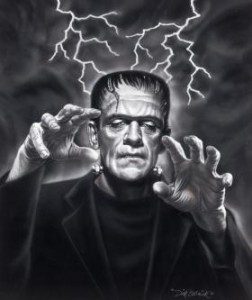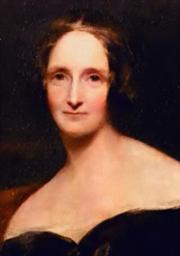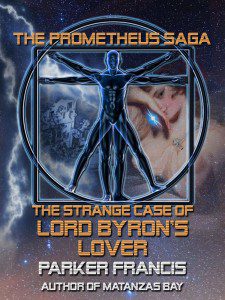 Most of us know that Mary Shelley wrote Frankenstein, thought to be the very first science fiction novel. The book was published in 1818, and quickly became a cult classic. But did you know that between 1910 and 1994 there were more than 70 major feature films made based either directly or indirectly on Shelley’s legendary character? You’ve probably seen some of them including, Young Frankenstein and Bride of Frankenstein, but how many of us are familiar with Frankenstein Meets the Space Monster? Or Frankenstein’s Great Aunt Tillie? I kid you not.
Most of us know that Mary Shelley wrote Frankenstein, thought to be the very first science fiction novel. The book was published in 1818, and quickly became a cult classic. But did you know that between 1910 and 1994 there were more than 70 major feature films made based either directly or indirectly on Shelley’s legendary character? You’ve probably seen some of them including, Young Frankenstein and Bride of Frankenstein, but how many of us are familiar with Frankenstein Meets the Space Monster? Or Frankenstein’s Great Aunt Tillie? I kid you not.
My Frankenstein mania came to a head when I was asked to be part of The Alvarium Experiment, which I blogged about last month. Fourteen award-winning authors riffing on a common theme about an alien race visiting earth 40,000 years ago, and leaving behind a human-like probe to keep track of the progress of the crude pre-historic creatures that were our ancestors. Each author had the freedom to place their story anywhere in that time span up to the present, using the “Prometheus” probe as one of the characters. Maybe because I tend to take things more literally than other people (just ask my wife), I thought about Mary Shelley and her famous story, which is titled Frankenstein: or, The Modern Prometheus.
This led me to dig into the circumstances surrounding how Ms. Shelley came to write Frankenstein. Amazingly, there was a wealth of historical information online about Mary, her husband Percy Bysshe Shelley, and their holiday on Lake Geneva with Lord Byron which over many a glass of wine resulted in her story. The meeting of these literary giants was memorable in many ways, and the idea for my story soon blossomed into a fascinating tale I titled The Strange Case of Lord Byron’s Lover.
Mary and Percy were not married at the time, though she’d taken to calling herself Mary Shelley, and they were married about six months after that June 1816 gathering at Byron’s Villa Diodati. She was 18 at the time, and quite a progressive woman considering this was the Victorian Age. Here’s one of the many portraits floating about the Internet of young Mary Shelley.
The Strange Case of Lord Byron’s Lover is told in Mary’s voice as she writes in her journal about some rather mystifying events which took place that summer. This is how the story begins:
My memory isn’t what it once was, but my past is written large within these pages. I beg you to indulge me as I recount a series of perplexing events occurring both before and after I wrote the Gothic opus for which I am known. My work achieved popular success, and even the indomitable Sir Walter Scott congratulated me for my “original genius and power of expression.”
However, lest you believe the story I’m about to share in the final pages of my journal is a prideful, self-congratulatory boast, let me assure you that I, Mary Shelley, have a far stranger tale to tell than the man-made monster of my fiction. And like the creature dredged from my nightmares, these events haunt me to this day.
The story is over 9,000 words in length and will be released for only $0.99 as a Kindle ebook, as will all 14 stories in the collection. Each story will have its own cover created by one of the authors, the singularly talented Charles Cornell. Here’s a sneak peek at the cover so you’ll know what to look for when you search for the story on Amazon.com next month.
Until then, here’s wishing everyone the very merriest of Christmases, the happiest of Hanukkahs, best wishes for us all for a more peaceful 2015, and may all of your monsters be of the literary variety.
